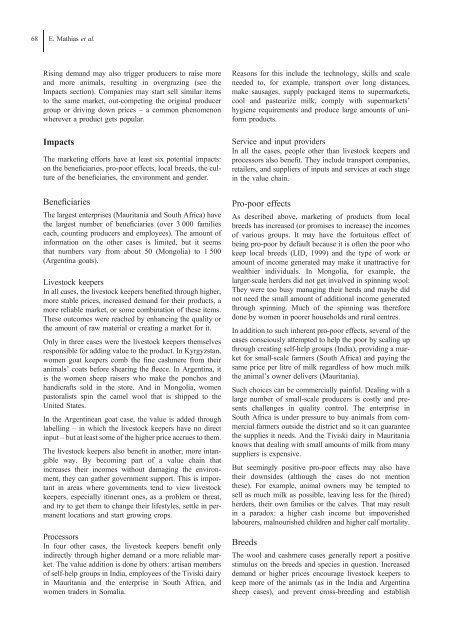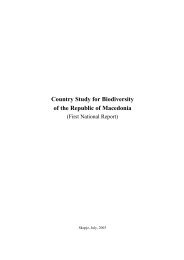Animal Genetic Resources - Convention on Biological Diversity
Animal Genetic Resources - Convention on Biological Diversity
Animal Genetic Resources - Convention on Biological Diversity
Create successful ePaper yourself
Turn your PDF publications into a flip-book with our unique Google optimized e-Paper software.
68 E. Mathias et al.<br />
Rising demand may also trigger producers to raise more<br />
and more animals, resulting in overgrazing (see the<br />
Impacts secti<strong>on</strong>). Companies may start sell similar items<br />
to the same market, out-competing the original producer<br />
group or driving down prices – a comm<strong>on</strong> phenomen<strong>on</strong><br />
wherever a product gets popular.<br />
Impacts<br />
The marketing efforts have at least six potential impacts:<br />
<strong>on</strong> the beneficiaries, pro-poor effects, local breeds, the culture<br />
of the beneficiaries, the envir<strong>on</strong>ment and gender.<br />
Beneficiaries<br />
The largest enterprises (Mauritania and South Africa) have<br />
the largest number of beneficiaries (over 3 000 families<br />
each, counting producers and employees). The amount of<br />
informati<strong>on</strong> <strong>on</strong> the other cases is limited, but it seems<br />
that numbers vary from about 50 (M<strong>on</strong>golia) to 1 500<br />
(Argentina goats).<br />
Livestock keepers<br />
In all cases, the livestock keepers benefited through higher,<br />
more stable prices, increased demand for their products, a<br />
more reliable market, or some combinati<strong>on</strong> of these items.<br />
These outcomes were reached by enhancing the quality or<br />
the amount of raw material or creating a market for it.<br />
Only in three cases were the livestock keepers themselves<br />
resp<strong>on</strong>sible for adding value to the product. In Kyrgyzstan,<br />
women goat keepers comb the fine cashmere from their<br />
animals’ coats before shearing the fleece. In Argentina, it<br />
is the women sheep raisers who make the p<strong>on</strong>chos and<br />
handicrafts sold in the store. And in M<strong>on</strong>golia, women<br />
pastoralists spin the camel wool that is shipped to the<br />
United States.<br />
In the Argentinean goat case, the value is added through<br />
labelling – in which the livestock keepers have no direct<br />
input – but at least some of the higher price accrues to them.<br />
The livestock keepers also benefit in another, more intangible<br />
way. By becoming part of a value chain that<br />
increases their incomes without damaging the envir<strong>on</strong>ment,<br />
they can gather government support. This is important<br />
in areas where governments tend to view livestock<br />
keepers, especially itinerant <strong>on</strong>es, as a problem or threat,<br />
and try to get them to change their lifestyles, settle in permanent<br />
locati<strong>on</strong>s and start growing crops.<br />
Processors<br />
In four other cases, the livestock keepers benefit <strong>on</strong>ly<br />
indirectly through higher demand or a more reliable market.<br />
The value additi<strong>on</strong> is d<strong>on</strong>e by others: artisan members<br />
of self-help groups in India, employees of the Tiviski dairy<br />
in Mauritania and the enterprise in South Africa, and<br />
women traders in Somalia.<br />
Reas<strong>on</strong>s for this include the technology, skills and scale<br />
needed to, for example, transport over l<strong>on</strong>g distances,<br />
make sausages, supply packaged items to supermarkets,<br />
cool and pasteurize milk, comply with supermarkets’<br />
hygiene requirements and produce large amounts of uniform<br />
products.<br />
Service and input providers<br />
In all the cases, people other than livestock keepers and<br />
processors also benefit. They include transport companies,<br />
retailers, and suppliers of inputs and services at each stage<br />
in the value chain.<br />
Pro-poor effects<br />
As described above, marketing of products from local<br />
breeds has increased (or promises to increase) the incomes<br />
of various groups. It may have the fortuitous effect of<br />
being pro-poor by default because it is often the poor who<br />
keep local breeds (LID, 1999) and the type of work or<br />
amount of income generated may make it unattractive for<br />
wealthier individuals. In M<strong>on</strong>golia, for example, the<br />
larger-scale herders did not get involved in spinning wool:<br />
They were too busy managing their herds and maybe did<br />
not need the small amount of additi<strong>on</strong>al income generated<br />
through spinning. Much of the spinning was therefore<br />
d<strong>on</strong>e by women in poorer households and rural centres.<br />
In additi<strong>on</strong> to such inherent pro-poor effects, several of the<br />
cases c<strong>on</strong>sciously attempted to help the poor by scaling up<br />
through creating self-help groups (India), providing a market<br />
for small-scale farmers (South Africa) and paying the<br />
same price per litre of milk regardless of how much milk<br />
the animal’s owner delivers (Mauritania).<br />
Such choices can be commercially painful. Dealing with a<br />
large number of small-scale producers is costly and presents<br />
challenges in quality c<strong>on</strong>trol. The enterprise in<br />
South Africa is under pressure to buy animals from commercial<br />
farmers outside the district and so it can guarantee<br />
the supplies it needs. And the Tiviski dairy in Mauritania<br />
knows that dealing with small amounts of milk from many<br />
suppliers is expensive.<br />
But seemingly positive pro-poor effects may also have<br />
their downsides (although the cases do not menti<strong>on</strong><br />
these). For example, animal owners may be tempted to<br />
sell as much milk as possible, leaving less for the (hired)<br />
herders, their own families or the calves. That may result<br />
in a paradox: a higher cash income but impoverished<br />
labourers, malnourished children and higher calf mortality.<br />
Breeds<br />
The wool and cashmere cases generally report a positive<br />
stimulus <strong>on</strong> the breeds and species in questi<strong>on</strong>. Increased<br />
demand or higher prices encourage livestock keepers to<br />
keep more of the animals (as in the India and Argentina<br />
sheep cases), and prevent cross-breeding and establish
















